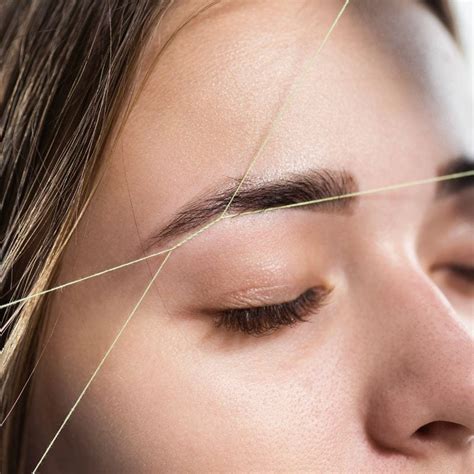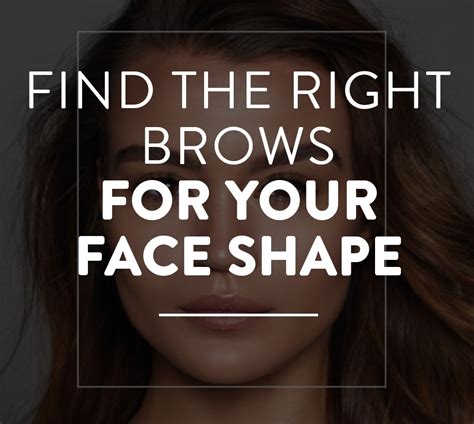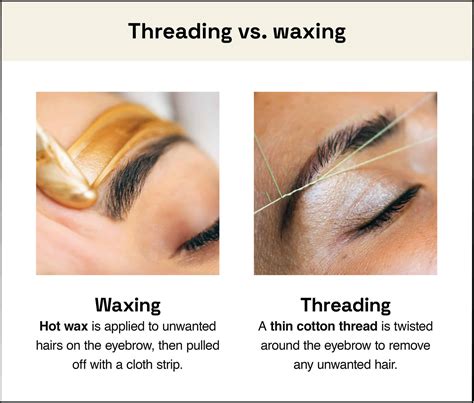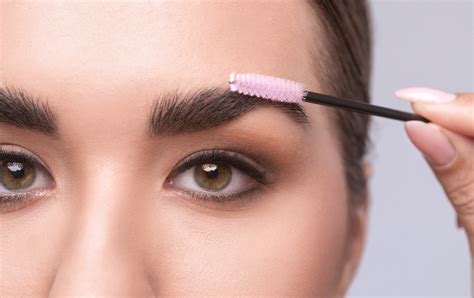Enhancing the allure of our face is an art that has been practiced and perfected for centuries. From ancient civilizations to modern trends, one facial feature that has always captivated the attention of beauty enthusiasts is the eyebrows. With their ability to frame our eyes and convey emotions, eyebrows hold a prominent place in our overall appearance. While there are various methods to shape and groom them, one technique that stands out for its precision and natural results is eyebrow threading.
This delicate art form involves using a thin thread to remove excess hair and sculpt the eyebrows into a desired shape. Unlike waxing or plucking, threading offers a more precise outcome, allowing for an impeccable arch and a clean definition. The thread is skillfully maneuvered by a trained esthetician, who expertly twists and pulls it against the skin, effectively removing even the finest of hairs at the follicle level. With the ability to create sharp lines and sculptural angles, threading transforms unruly brows into elegantly shaped works of art.
Although eyebrow threading may seem like a new trend, its origins can be traced back to ancient Eastern cultures. This traditional method was initially practiced in India and other parts of South Asia, where it was used not only for cosmetic purposes but also as a cultural and social tradition. The art of threading was passed down through generations, with mothers teaching their daughters the intricate techniques and secrets to achieving flawless brows.
Today, threading has gained immense popularity across the globe, attracting individuals who seek a more natural and precise way to shape their eyebrows. Its popularity can be attributed not only to the aesthetics it offers but also to its hygienic advantages. Threading eliminates the risk of allergic reactions often associated with waxing or chemical hair removal products, making it a safer option for those with sensitive skin. Furthermore, the lack of chemicals and minimal use of tools make threading a more environmentally friendly choice.
The History of Eyebrow Threading: Ancient Technique, Modern Trends

Discover the captivating journey of eyebrow threading, an ancient technique that has evolved into a modern beauty trend. Throughout the ages, cultures around the world have embraced the art of shaping eyebrows, and eyebrow threading has emerged as a popular method for achieving perfectly groomed brows.
Derived from ancient practices originating in Asia, eyebrow threading involves using a twisted thread to remove unwanted hair follicles from the root. This precise and meticulous technique allows for greater control and accuracy, resulting in a clean and defined eyebrow shape.
Historical records indicate that threading was widely practiced in ancient civilizations such as Egypt, India, and Persia. It was not only a method of hair removal but also held cultural significance, with different eyebrow shapes symbolizing various social statuses and beauty ideals.
While threading remained prominent in certain regions throughout history, it gained global recognition in recent decades, thanks to its natural and low-tolerance approach. Unlike other methods like waxing or tweezing, threading is known for being gentle on the skin and suitable for all skin types, including sensitive or acne-prone skin.
In the modern era, eyebrow threading has become a highly sought-after beauty technique. It is favored by those seeking a more sustainable alternative to chemical treatments and a precise and long-lasting brow shape. Additionally, the rise of influencers and social media has popularized various eyebrow trends, such as thick and full brows or more delicately arched shapes.
As eyebrow threading continues to gain popularity worldwide, it remains rooted in its ancient origins, honoring the cultural heritage of shaping eyebrows. With its combination of artistry and technique, eyebrow threading has transformed into a modern trend that offers individuals the opportunity to express their unique beauty preferences.
Uncover the Origins and Evolution of the Ancient Technique: Eyebrow Threading
Embark on a journey through time as we delve into the fascinating history of eyebrow threading and trace its evolution to the art form it is today. This ancient technique, which involves using a twisted thread to meticulously shape and groom eyebrows, has its roots in the cultural traditions of the Middle East and South Asia.
Threading, a method that is also known by diverse names such as "khite" or "fatlah," has been practiced for centuries by skilled artisans who mastered the intricate skill. Originating in regions known for their rich cultural heritage, threading was not only a way to enhance one's appearance but also held deeper symbolic significance in many societies.
- Early Origins
- Spread and Influence
- Modern Adaptations
- Contemporary Innovations
Although the exact origins of threading are difficult to trace, it is believed to have originated in ancient Persia, now known as Iran. Skilled artisans in Persia developed this technique as a way to remove unwanted facial hair and shape eyebrows. Over time, the practice spread to other areas of the Middle East and parts of South Asia.
As trade routes expanded and cultural exchange flourished, the art of threading made its way throughout the Middle East and Asia. It gained popularity among both women and men, with individuals seeking the precise and defined eyebrow shapes that threading could achieve.
In recent years, eyebrow threading has gained significant traction and appreciation in Western countries. Salons and estheticians now offer professional threading services, catering to a diverse clientele. The technique has also undergone slight modifications and adaptations to suit different eyebrow preferences and individual styles.
With the advancements in beauty technology, there have been innovations in threading techniques. From the use of specialized threads and tools to the introduction of electric threading devices, the art of eyebrow threading has evolved while staying true to its core principles.
Today, threading holds a prominent place in the world of beauty and self-care, offering individuals an alternative to other conventional methods of eyebrow grooming. Whether you appreciate its historical significance or simply desire the perfectly shaped eyebrows it can achieve, threading continues to captivate enthusiasts worldwide with its rich heritage and ongoing innovation.
Perfecting the Shape: Tips for Achieving Your Desired Brow Arches

When it comes to achieving your ideal eyebrow arches, there are a few key tips and techniques that can help you perfect the shape without the use of eyebrow threading. Whether you prefer a bold, dramatic arch or a subtle, natural curve, these tips will guide you in creating eyebrows that beautifully frame your face and enhance your natural features.
1. Determine Your Desired Arch: Before you start shaping your eyebrows, it's important to have a clear idea of the arch shape you want to achieve. Look at pictures of eyebrows and find inspiration that aligns with your personal style and face shape. Keep in mind that eyebrow trends change over time, so choose a shape that suits you and makes you feel confident.
2. Start with Clean and Groomed Brows: To ensure precise shaping, start with clean and groomed eyebrows. Remove any stray hairs and trim the longer ones to create a neater appearance. Brush your eyebrows upwards using a clean spoolie brush to reveal their natural shape and determine where the arch should be placed.
3. Map Out the Shape: Using an eyebrow pencil or a thin brush with an eyebrow powder, map out the desired shape of your eyebrows. Begin by marking the starting point, which should align with the inner corner of your eye. Then, mark the highest point of the arch, which should align with the outer edge of your iris. Finally, mark the end point, which should align with the outer corner of your eye. This mapping technique will serve as a guide while shaping your brows.
4. Shape Your Brows: Use a pair of angled tweezers to carefully pluck the unwanted hairs outside the mapped-out shape. Start by removing hairs from the bottom of your brow, working your way towards the arch. Be cautious not to over-tweeze and create a too-thin shape. Refine the arch by tweezing a few hairs from above, if necessary. Remember to pluck in the direction of hair growth to minimize discomfort.
5. Fill in and Define: Once your brows are shaped, use an eyebrow pencil or powder to fill in any sparse areas and define the shape further. Use short, feathery strokes to mimic the appearance of natural hair and create a seamless blend. Choose a color that closely matches your natural brow color for a more natural look.
6. Set and Maintain: To ensure your perfectly shaped eyebrows stay in place throughout the day, set them with a clear or tinted eyebrow gel. This will help keep them looking groomed and hold the shape in place. Additionally, regularly trim any longer hairs and touch up your brows as needed to maintain the desired shape.
By following these tips and techniques, you can easily perfect the shape of your eyebrows, enhancing your overall appearance and achieving the ideal brow arches that best suit you.
Get Expert Insights on Enhancing Your Eyebrows with Threading Techniques
Eyebrows are an essential feature that frames the face and can enhance your overall appearance. If you're looking to achieve professionally shaped eyebrows, threading techniques can be a game-changer. This section aims to provide you with valuable tips and insights from experts on how to shape your eyebrows using threading, a method known for its precision and long-lasting results.
1. Start with proper preparation:
- Before you begin threading, ensure that your eyebrows are clean and free from any makeup or oil. This will allow the thread to grip the hairs better and provide more precise shaping.
- Consider using a numbing cream or ice to minimize discomfort during the threading process.
- Have a mirror, cotton pads, and a soothing gel or aloe vera handy to clean and calm the area after threading.
2. Understand the threading technique:
- Threading involves using a twisted thread to remove unwanted hair from the root. Practice the correct hand positioning and movement to achieve the desired outcome.
- Learn the different threading styles, such as the straight line, soft curve, or angled arch, and identify the shape that suits your face the best.
- It's important to be patient and take your time when threading to avoid any mistakes or over-plucking.
3. Seek professional guidance:
- If you're new to threading or unsure about shaping your eyebrows, consider visiting a professional eyebrow threading salon.
- An experienced esthetician can assess your face shape, bone structure, and personal preferences to give you tailored advice and create the perfect eyebrow shape for you.
- They can also provide valuable aftercare tips to maintain your newly shaped eyebrows.
4. Practice regular maintenance:
- To keep your eyebrows looking their best, incorporate regular threading sessions into your beauty routine.
- Determine a schedule that suits your hair growth pattern, but remember that over-plucking or threading too frequently can lead to sparse eyebrows.
- Use a brow brush or spoolie to groom your eyebrows daily and keep them in place.
By following these professional tips and gaining a deeper understanding of threading techniques, you can take control of shaping your eyebrows and achieve the desired look that enhances your unique features. Remember to always prioritize self-care and consult with experts when needed to achieve the best results.
Threading vs. Waxing: Which Method is Right for You?

When it comes to grooming your eyebrows, there are different methods that can help you achieve your desired look. Two popular techniques are threading and waxing. Each method offers its own advantages and it's important to consider your personal preferences and needs when choosing the right one for you.
Threading is a technique that uses a twisted thread to remove hair from the root. This method has been practiced for centuries and is known for its precise and clean results. It offers more control, allowing the technician to shape and define your eyebrows according to your facial features. Threading is also a preferred option for those with sensitive skin, as it is gentle and less likely to cause irritation. Furthermore, threading is a more natural approach as it doesn't involve the use of chemicals.
On the other hand, waxing is a method that involves applying warm or cold wax to the eyebrow area and then removing it with a strip. This technique is fast and efficient, making it a popular choice for those who want a quick and long-lasting result. Waxing can remove a larger amount of hair at once, making it suitable for those with thicker eyebrows. However, it can be a bit more painful and is not recommended for those with sensitive skin or certain skin conditions.
| Threading | Waxing |
|---|---|
| Offers precise and clean results | Provides quick and long-lasting results |
| More control in shaping the eyebrows | Can remove a larger amount of hair at once |
| Gentle and suitable for sensitive skin | Potential for more pain and irritation |
| A more natural approach | Faster and more efficient |
Ultimately, the choice between threading and waxing depends on your personal preferences and needs. If you prefer a precise and gentle approach with more control over shaping your eyebrows, threading may be the right choice for you. On the other hand, if you value speed and efficiency, along with the ability to remove a larger amount of hair at once, waxing may be the better option. It's always recommended to consult with a professional technician who can assess your specific needs and guide you in making the best choice for your eyebrows.
Exploring the Advantages and Disadvantages of Eyebrow Threading and Waxing for Brow Shaping
In this section, we will delve into the merits and drawbacks of two popular methods used for achieving well-groomed eyebrows: threading and waxing. We will examine the advantages and disadvantages of each technique, allowing you to make an informed decision about which method may be best suited to your individual preferences and needs.
Threading
For those seeking a precise and meticulous approach to eyebrow shaping, threading offers numerous benefits. This ancient technique involves using a looped thread to carefully remove unwanted hair, resulting in clean and defined brows. Threading allows for greater control, allowing the technician to shape the eyebrows with precision. Moreover, threading is known for its ability to create sharp and well-defined angles, giving your brows a polished and sculpted look.
Yet, threading is not without its drawbacks. Some individuals may find the process of threading uncomfortable, as it involves the sensation of tugging and pulling on the skin. Additionally, threading may not be suitable for those with sensitive skin, as it can potentially cause irritation or redness in some cases. It is also worth noting that threading is a time-consuming process, requiring a skilled technician who can dedicate the necessary attention to detail.
Waxing
Waxing offers an efficient and quick method for achieving beautifully shaped eyebrows. This technique involves the application of warm wax to the desired area, which is then removed along with the unwanted hair. Waxing not only removes hair from the follicle, resulting in longer-lasting results, but it also exfoliates the skin, leaving it feeling smooth and rejuvenated.
However, waxing is not without its downsides. Some individuals may find the process uncomfortable or even painful, as the warm wax adheres to the skin and is subsequently removed. Furthermore, waxing requires regrowth of hair to a certain length before it can be effectively removed, which may not be ideal for those who prefer a consistently groomed appearance. Additionally, waxing can sometimes cause temporary redness or irritation, particularly for individuals with sensitive skin.
It is important to weigh the advantages and disadvantages of threading and waxing when considering the ideal technique for eyebrow shaping. Ultimately, the choice ultimately depends on personal preferences, pain tolerance, and desired results.
Exploring the Advantages of Brow Threading: Beyond Enhancing and Crafting

In the pursuit of achieving beautiful brows, eyebrow threading has emerged as a renowned technique that offers a multitude of benefits. While commonly associated with shaping and sculpting, this ancient method provides advantages that extend far beyond mere aesthetic results. With its distinctive technique and numerous advantages, brow threading has become a popular choice for individuals seeking a comprehensive solution for their eyebrow needs.
1. Precise and Customizable Results
One of the key benefits of eyebrow threading lies in its ability to provide precise and customizable results. Unlike other methods, such as waxing or tweezing, threading allows for intricate shaping and detailing, tailored specifically to each individual's unique facial features. This level of precision ensures that the desired brow shape is achieved, resulting in a more defined and harmonious appearance.
2. Gentle and Painless
Compared to alternative techniques, eyebrow threading is known for its gentle and relatively painless process. The use of a cotton thread allows for the removal of unwanted hair with minimal discomfort. This makes threading an ideal choice for individuals with sensitive skin or those who have had negative experiences with other hair removal methods in the past.
3. Longer Lasting Results
Another advantage of eyebrow threading is its ability to provide longer lasting results. Unlike plucking or waxing, which may require frequent touch-ups, threading allows for the removal of hair from the root. This delays the regrowth process, resulting in eyebrows that remain well-groomed and defined for a longer period of time.
4. Reduced Skin Irritation
For individuals with sensitive skin, eyebrow threading offers a gentler alternative to other hair removal techniques. The absence of harsh chemicals and the minimal contact with the skin during threading significantly reduces the risk of skin irritation and allergic reactions. This makes threading a suitable option for those prone to skin sensitivity or allergies.
5. Versatility and Versatility
Beyond its primary purpose of shaping and enhancing eyebrows, threading also offers versatility in its application. The technique can be utilized to remove unwanted facial hair, such as fuzzy hair on the upper lip, chin, or sideburns. This makes threading a comprehensive and versatile solution for various hair removal needs.
In conclusion, eyebrow threading goes beyond the traditional notions of shaping and sculpting brows. With its precise and customizable results, gentle process, long-lasting effects, reduced skin irritation, and versatile application, threading proves to be an advantageous method for achieving well-groomed and defined eyebrows, as well as addressing other facial hair removal needs.
FAQ
What is eyebrow threading and how does it work?
Eyebrow threading is a technique used to shape the eyebrows by removing excess hair using a thin thread. The thread is twisted and rolled over the hair, catching multiple hairs at once and removing them from the follicle.
Is eyebrow threading painful?
Some people may experience mild discomfort during eyebrow threading, but it is generally less painful compared to other hair removal methods like waxing. The sensation can be likened to a quick pinching feeling.
How long does eyebrow threading last?
The results of eyebrow threading can last anywhere from 2 to 6 weeks, depending on individual hair growth. However, regular maintenance may be required to keep the shape and neatness of the eyebrows.



